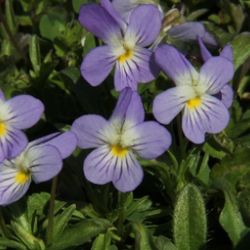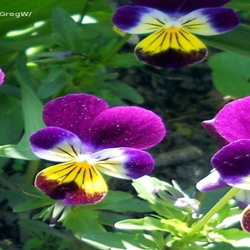The opening photo shows a wild Viola from my yard in Delaware (USA). These adorable little dainties are everywhere in the yard in spring, even in wood piles or under old rubber tires. They are more rugged than they appear. And they seem to appear everywhere, out of nowhere. One of my favorite things to do on a mild spring day is to go in search of the ones with the most purple on their petals. Some of these violas have purple dots on their petal tips instead of a purple swath of color, leading me to marvel at the science of genetics and to wonder what would happen if I transplanted the most unique ones into my flower beds.
Speaking of genetics, while trying to nail down this exact species, I started with searching the Web for Viola tricolor. The name Viola tricolor x arvensis = V. x contempta kept coming up as I searched on Google. However, the variant "contempta" is apparently still under review but popular among European botanical sites. I did find a helpful photo database of violas which is pleasing to the eye and in keeping with the mood I am trying to convey: sweet surprises in early spring.
Even though the purple-tipped beauty above is called a Viola tricolor; you may call it a Johnny Jump-up, Wild Pansy, or even Heartsease if you want to. I call it pretty.
Pictured here on the left is a variant that is definitely in the same family of little wild violas. This little one is much more delicately-colored, shorter, and a bit less striking but nonetheless delightful. Again, I consulted the Dave's Garden Viola database of violas without cultivars (alphabetically) to search for my specimen. In this case, I have identified this little cutie as a Viola bicolor, or American field pansy.
And what would spring be without good old-fashioned violets? My yard is full of the solid purple variety of Viola sororia as well as the variegated ones. These violets, as do many plants in the viola family, spread in an agressive manner, even spreading via infertile seed underground! Wow! So that is why I can never really get rid of them. But why would I ever want to? They give so much pleasure in the spring yet ask for little in return, and I do so look forward to their blooming season.
My violets grow best in filtered sun or part shade. They do okay in full sun, but the leaves take on a yellower hue as if to say, "Please give us just a little shade." When I do, they thrive all the more.
I have long ago given up on removing violets from my yard. They spread freely, and I let them do so. After their flowering period is over at the end of spring, they make pretty clumps of heart-shaped, dark green foliage.
Finally, the story is not complete without the tale of the Pansies that kept coming back. The blue pansies in the photo on the lower left were purchased as bedding flowers a few years ago. They were so pretty that I took plenty of pictures of them: I could not stop.
As I focused in on the cluster of store-bought pansies, the "Face Recognition" feature on my digital camera enclosed each pansy "face" in a square outline in my viewfinder. Haha! What does that tell you about pansies but that they really DO have faces! Sometimes they look as though they are making grumpy faces, don't you agreee?
For the next two years, the pansies popped up again, though technically they are marketed as a cool-season annual to be planted in either spring or fall for a short-lived moment of color. They must have been happy out in the front flower bed to reward me with such a pleasant surprise.

There you have it, and I hope I have not left out any other violas that grace my humble home. It is always a mood-lifter when my favorite violas come to life in the spring, and so I look forward to their window of glory each year.

That is probably why spring is my favorite season.

















